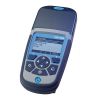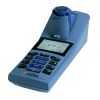YSI 9800 Photometer
Features
- Waterproof IP-67 rating even when using a USB connection to power the instrument
- Large, full-color touchscreen display works even with wet or gloved hands
- Choose from 100+ tests or define your own
- Free ground shipping
- Expedited repair and warranty service
- Lifetime technical support
- More
The YSI 9800 is a portable, multiparameter photometer for quickly and accurately measuring over 30 water quality parameters. For use in the field or lab and featuring a large touchscreen display and an intuitive user interface with onscreen instructions, the 9800 Photometer is the ideal instrument for users of any level of experience operating in any environment!
Rugged and Modern
Waterproof IP-67 rating even when using a USB connection to power the instrument
Impact tested
Abrasion-resistant and chemical-resistant coating
Large, full-color touchscreen display works even with wet or gloved hands
Onscreen step-by-step test instructions
Comfrotable, ergonomic design
Smart, Versatile
Choose from 100+ tests or define your own
Multiple languages, including English, French, Spanish, and Mandarin
User-selectable options for test units, sample numbers, and dilution factors
Automatically stores all test results, data IDs, and user information for data compliance and traceability
Simple Data Management via USB connectivity also powers the instrument
User-upgradeable software via USB connection to PC
1,000 Data Set Memory
Sustainable
Fully serviceable and repairable over the life of the instrument
Carrying case composed of 100% recycled materials
Longer-lasting battery life (up to 5,000 tests per set)
| Instrument Type | Multiparameter Photometer |
| Wavelengths | 430 nm, 465 nm, 530 nm, 575 nm, 620 nm |
| Accuracy | ± 1%T (transmission) |
| Display | Large, Color LCD |
| User Interface | Touch screen with walkthrough text instructions |
| Dimensions |
Width: 211 mm (8.3 in)
Length: 195 mm (7.7 in)
Height: 52 mm (2.0 in)
|
| Weight | 0.85 kg (1.87 lbs) |
| IP Rating | IP-67 |
| Power Supply | 6x AA Batteries or through USB |
| Connectivity | Connect to PC via USB cable |
| Memory Capacity | 1,000 data sets |
| Battery Life | 5,000 tests on one set of batteries |
| Languages | English, French, Spanish, and Chinese (Simplified) |
| Certifications | EN61326, EN61010, IP67, and EN60068-2-78 |
- (1) 9800 Photometer
- (1) Dilution tube
- (1) Syringe (luer slip, 10mL)
- (1) Polishing cloth
- (1) Absorbent cloth
- (1) Test tube brush
- (10) Test tubes
- (10) Stir rods
- (1) USB Type A to C cable
- (1) Reagent box
- (1) Carrying case
- (1) Quick Start Guide
In The News
Expanding the Port Everglades: Real-Time Monitoring of Water Quality Conditions from Planned Dredging Operation
The Port Everglades in Broward County, Florida, serves large trade vessels and cruiseliners and incoming and outgoing recreational boaters. However, as cargo ships become larger, the port must expand. A dredging project led by the US Army Corps of Engineers will substantially deepen and widen the port's navigation channel to accommodate larger Panamax cargo ships and modern cruise liners. As a result of this project, a large amount of sediment will be displaced into the water column. This suspended sediment may settle outside of the project area, burying benthic organisms like corals, and possibly carrying harmful particulates to other regions. [caption id="attachment_39497" align="aligncenter" width="2560"] A CB-950 and CB-25 deployed on site at Port Everglades.
Read MoreIt’s Time to React to Water Quality: Proteus Multiparameter Probe aboard NexSens Buoy
Water quality monitoring is essential for safeguarding public health, protecting ecosystems, and ensuring the sustainability of water resources. Contaminants such as industrial pollutants, agricultural runoff, and sewage discharge can severely impact aquatic life and pose serious risks to human health if left unchecked. Traditionally, water quality monitoring has been a slow and labor-intensive process, requiring samples to be collected, transported to a lab, and analyzed—a process that can take days. However, with the advancement of real-time sensor technology, environmental agencies, researchers, and industries can now monitor water quality instantly.
Read MoreSafeguarding Communities with Real-Time Flood Monitoring in the City of Hazelwood
The City of Hazelwood is a suburb in St. Louis County, Missouri, home to around 25,500 people. Recently, the community has suffered increased flash flooding following severe storms, prompting the need for the installation of a flood monitoring system. In 2022, a NexSens X2 data logger was installed to monitor water level and rainfall in real-time, with the aim of reducing the loss of life and property as a result of extreme weather events. [caption id="attachment_39411" align="alignnone" width="940"] The latest flood event at Coldwater Creek, where the water level rose by 14 feet, exceeding the height of the X2 by three feet. The sensor can be seen behind the wall that usually contains the Creek.
Read More


































































